
Artemisia is a large, diverse genus of plants with between 200 and 400 species belonging to the daisy family Asteraceae. Common names for various species in the genus include mugwort, wormwood, and sagebrush.
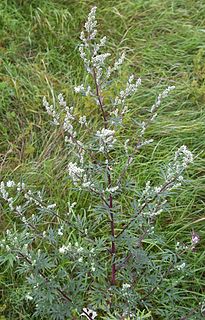
Artemisia vulgaris, the common mugwort, is a species of flowering plant in the daisy family Asteraceae. It is one of several species in the genus Artemisia commonly known as mugwort, although Artemisia vulgaris is the species most often called mugwort. It is also occasionally known as riverside wormwood, felon herb, chrysanthemum weed, wild wormwood, old Uncle Henry, sailor's tobacco, naughty man, old man or St. John's plant. Mugworts have been used medicinally and as culinary herbs.
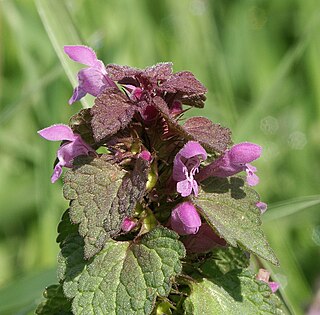
Lamium purpureum, known as red dead-nettle, purple dead-nettle, or purple archangel, is a herbaceous flowering plant native to Europe and Asia.

Artemisia tridentata, commonly called big sagebrush, Great Basin sagebrush or (locally) simply sagebrush, is an aromatic shrub from the family Asteraceae, which grows in arid and semi-arid conditions, throughout a range of cold desert, steppe, and mountain habitats in the Intermountain West of North America. The vernacular name "sagebrush" is also used for several related members of the genus Artemisia, such as California sagebrush.

Fagus orientalis, commonly known as the Oriental beech, is a deciduous tree in the beech family Fagaceae. It is native to Eurasia, in Eastern Europe and Western Asia.

Drosera rotundifolia, the round-leaved sundew or common sundew, is a carnivorous species of flowering plant that grows in bogs, marshes and fens. One of the most widespread sundew species, it has a circumboreal distribution, being found in all of northern Europe, much of Siberia, large parts of northern North America, Korea and Japan but is also found as far south as California, Mississippi and Alabama in the United States of America and in New Guinea.
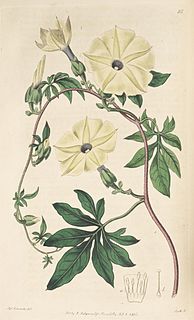
Ipomoea tuberculata is a flowering plant species in the bindweed family (Convolvulaceae). It belongs to the morning glory genus, Ipomoea.
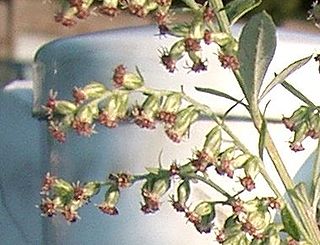
Artemisia princeps, also called Korean wormwood, Korean mugwort, and Japanese mugwort in English, is an Asian plant species in the sunflower family, native to China, Japan, and Korea. It is a perennial, very vigorous plant that grows to 1.2 meters. This species spreads rapidly by means of underground stolons and can become invasive. It bears small, buff-colored flowers from July to November which are hermaphroditic, and pollinated by wind. The leaves are feather shaped, scalloped and light green, with white dense fuzz on the underside.
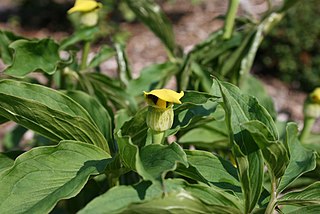
Arisaema flavum is a species of flowering plant widespread across north-eastern Africa and southern Asia. It is native to Ethiopia, Somalia, the Arabian Peninsula, Pakistan, Afghanistan, Nepal, Assam, Himalayas, Tibet, Yunnan, and Sichuan. The species epithet flavum is Latin for yellow and indicates its flower colour.

Artemisia borealis is an arctic and alpine species of plant in the sunflower family. Some common names are: boreal sage, boreal wormwood and boreal sagewort. It is native to high latitudes and high elevations in Eurasia and North America. In North America, it can be found in Alaska, Greenland, the Canadian Arctic, and the Rockies, Cascades, and Sierra Nevada as far south as Arizona and New Mexico. In Eurasia, it is widespread across European and Asiatic Russia and also grows in Scandinavia and in the mountains of central Europe

Hellinsia lienigianus is a moth of the family Pterophoridae which inhabits coastal areas, dry pastures and waste ground and is found in Africa, Asia, Australia and Europe. Also known as the mugwort plume it was first described by Philipp Christoph Zeller in 1852.

Artemisia cana is a species of sagebrush native to western and central North America, a member of the sunflower family. It is known by many common names, including silver sagebrush, sticky sagebrush, silver wormwood, hoary sagebrush, and dwarf sagebrush.

The Kazakh semi-desert is an ecoregion in the deserts and xeric shrublands biome, located in Kazakhstan. The climate is semi-arid and continental, with a total annual precipitation of 160 millimetres (6.3 in), and mean temperatures in January averaging −15 °C (5 °F) and in July 23 °C (73 °F). It is a transitional area between the steppes and the deserts of Central Asia and supports flora found in both biomes, predominantly grasses, particularly Stipa species, and shrubs such as Artemisia species. A number of mammals and birds are found in this ecoregion but the habitat is threatened by overgrazing and fragmentation from human encroachment. However, a recent reduction in livestock numbers in Kazakhstan is allowing the native plants a greater opportunity to regenerate.
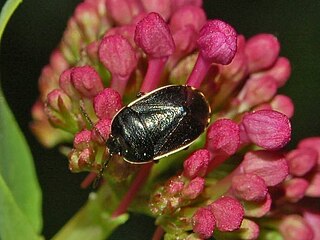
Canthophorus dubius is a species of burrowing bugs or negro bugs belonging to the family Cydnidae, subfamily Sehirinae.

Calliptamus italicus, the Italian locust, is a species of 'short-horned grasshopper' belonging to the family Acrididae, subfamily Calliptaminae.

Phycitodes binaevella is a species of snout moth described by Jacob Hübner in 1813. It is found in most of Europe, Asia Minor, Lebanon and the Palestinian Territories.
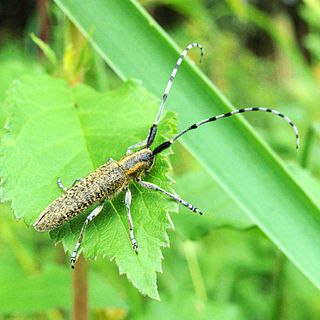
Agapanthia villosoviridescens, also known as the golden-bloomed grey longhorn beetle, is a species of beetle in the subfamily Lamiinae, found in the Caucasus, Europe, Kazakhstan, the Near East, Russia and Turkey.
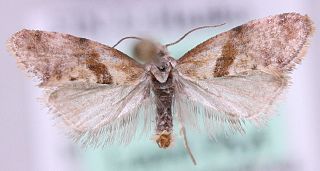
Cochylidia implicitana, the chamomile conch, is a moth of the family Tortricidae. It was described by Wocke in 1856. It is found in most of Europe, except Ireland and most of the Balkan Peninsula. Outside of Europe, it is found in Morocco, the Alatau mountains in Central Asia, Iran and China (Xinjiang). The habitat consists of waste ground and verges.

Eucosma pupillana is a species of moth of the family Tortricidae.

Hakea lissosperma, commonly known as needle bush and mountain needlewood, is a species of Hakea native to parts of south eastern Australia.




















